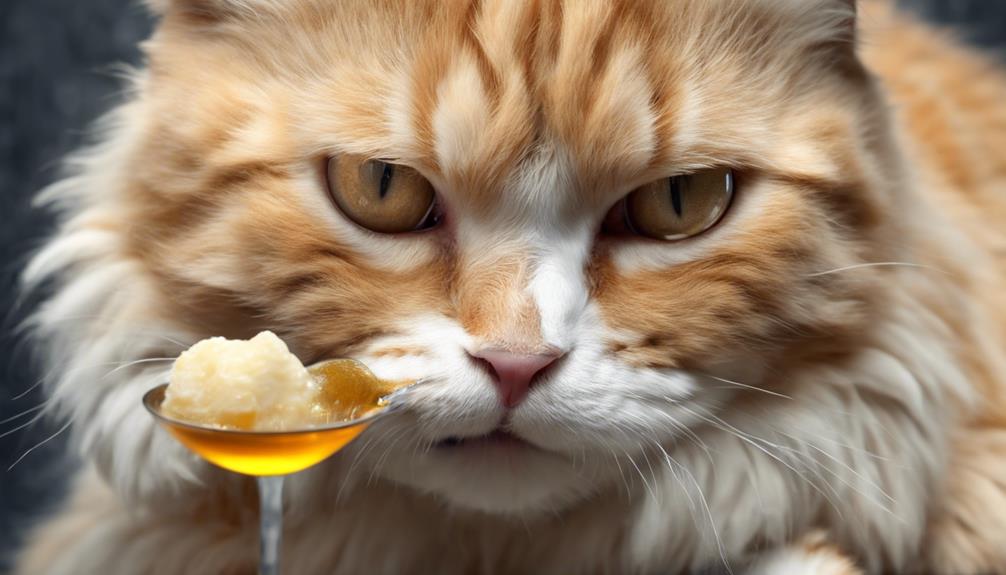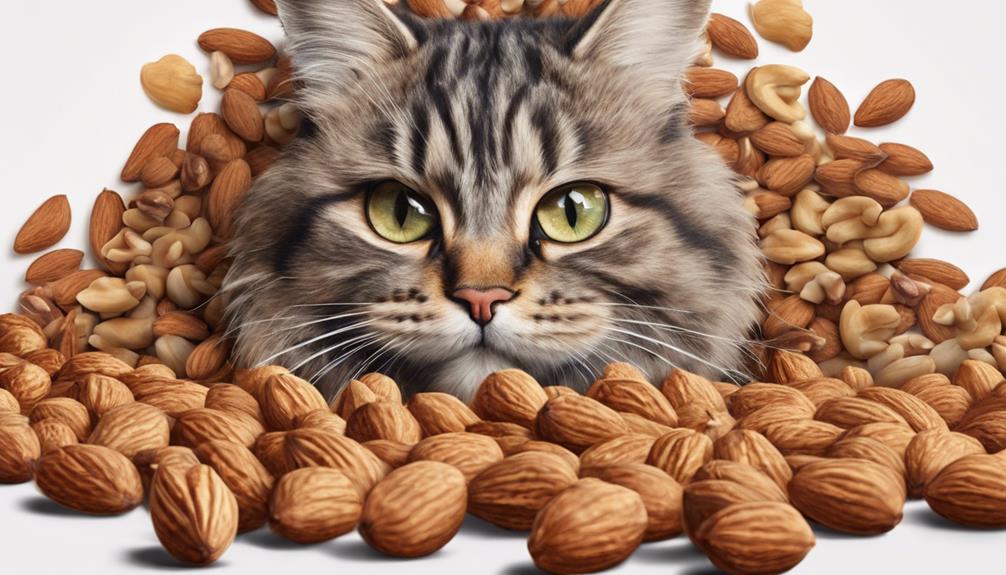Cats should steer clear of honey because they lack the enzymes needed to digest it properly. This can result in digestive issues and potential allergies for our feline friends. The high sugar content in honey can have negative effects on a cat’s health, such as weight gain and metabolic problems. It is crucial to consult with a veterinarian before giving any honey to your pet to ensure their well-being. Additionally, cats thrive on diets rich in animal protein, making honey an inappropriate choice for their nutritional needs. Understanding your cat’s specific dietary requirements is essential for maintaining their long-term health. Further information about cats and honey can offer valuable insights for responsible pet care.
Key Takeaways
- Cats lack enzymes to digest honey sugars effectively.
- Feeding honey can lead to adverse effects like vomiting and diarrhea.
- High calorie content in honey may contribute to obesity in cats.
- Raw honey can harbor harmful botulism spores, especially risky for kittens.
- Consulting a vet is crucial before considering offering honey to cats.
Honey and Cats: A Risky Combination
When considering the safety of cats consuming honey, it's important to acknowledge that it poses risks due to their inability to properly digest sugars. Cats lack the necessary enzymes to break down the glucose and fructose found in honey, making it challenging for them to process carbohydrates effectively.
While honey may offer potential health benefits in humans, such as antioxidants and antibacterial properties, these advantages don't necessarily translate to felines. Feeding honey to cats can result in adverse effects like gagging, vomiting, and diarrhea due to their sensitive digestive systems. Additionally, the high calorie content in honey could contribute to obesity in cats if consumed regularly or in large amounts.
Raw honey presents an even greater danger, as it may harbor botulism spores that could be especially harmful to young kittens with developing immune systems. Hence, it's advisable to avoid giving honey to cats to prevent stomach upsets and other related health concerns.
Understanding Cats Sweet Taste Perception
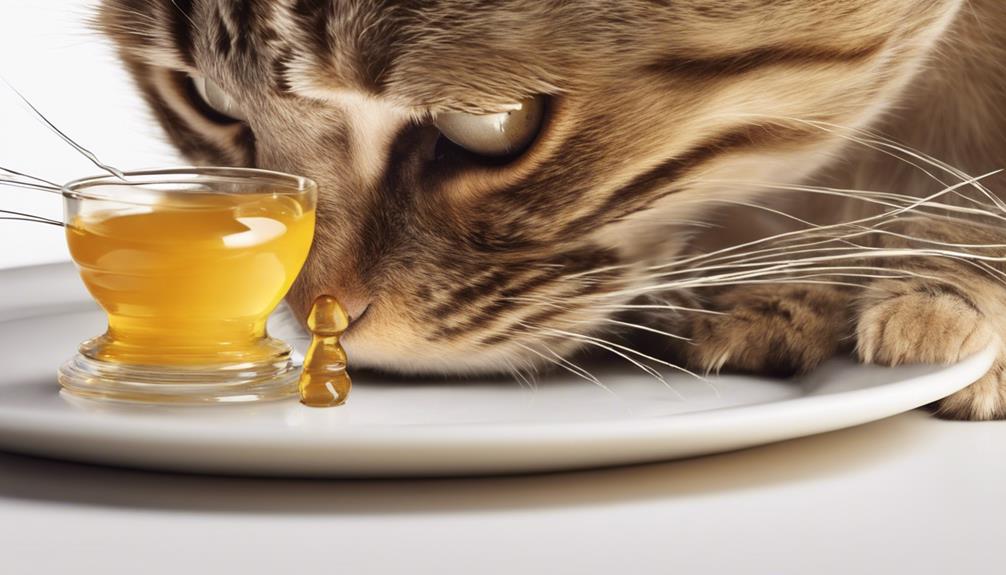
Understanding how cats perceive sweetness in their diet is essential in determining their dietary preferences and nutritional needs. Cats lack the gene for tasting sweet foods like honey, which means they don't have a preference for sugar in their diet. Research shows that cats may be more attracted to fats, proteins, or other components in food rather than sweetness. While the aromatic qualities of honey may appeal to cats, they're unlikely to experience its sweetness due to their physiological makeup as true carnivores not suited for high sugar content foods like honey.
As cat lovers, it's important for us to recognize that our feline friends have unique taste perceptions. Contrary to our own enjoyment of sweet treats, cats simply don't share the same fondness for sugary foods. By understanding this aspect of their taste preferences, we can make more informed choices when it comes to their diets and overall well-being.
Potential Health Risks of Cats Consuming Honey
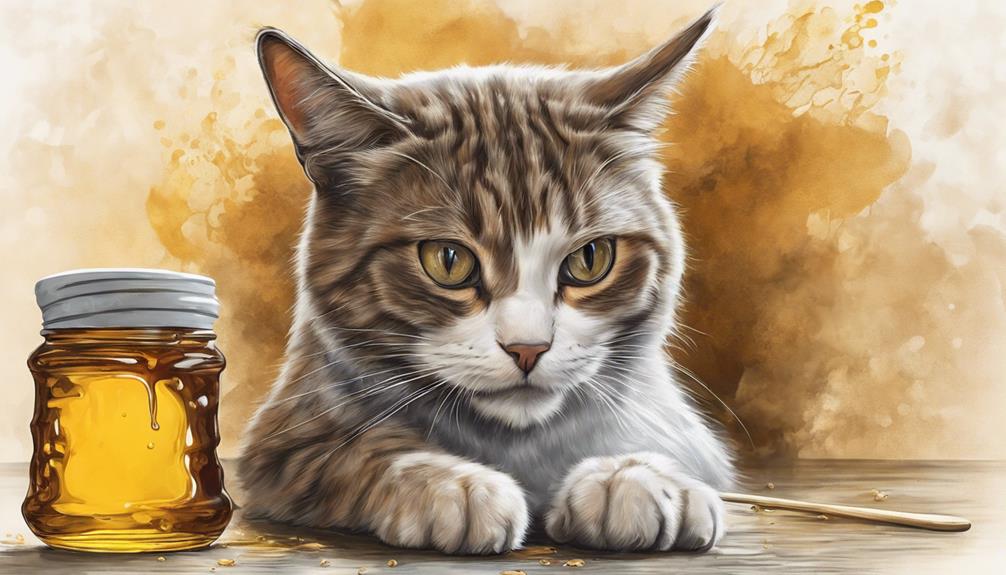
When pondering the potential health risks of cats consuming honey, it's crucial to emphasize the impact on feline health and the possibility of allergic reactions in cats.
Cats lack the enzymes required to effectively digest the sugars in honey, which can result in gastrointestinal problems like vomiting and diarrhea.
Moreover, giving cats honey may not align with their carnivorous nature and can lead to obesity due to its high calorie content.
Honey and Feline Health
In considering the potential health risks of cats consuming honey, it becomes evident that felines lack the necessary enzymes to properly digest the sugars present in honey, leading to potential gastrointestinal issues.
- Honey can lead to weight gain and obesity in cats due to its high calorie content.
- Regular honey consumption can result in insulin spikes, disrupting a cat's metabolism.
- Cats are obligate carnivores, emphasizing the importance of avoiding sugary foods like honey.
- Feeding honey to cats is unnecessary and can potentially lead to long-term health problems.
- Cats should primarily consume animal protein-based diets, making honey a harmful addition to their nutrition.
Allergic Reactions in Cats
Cats may experience allergic reactions, such as digestive issues and vomiting when consuming honey, highlighting potential health risks associated with this sweet treat for felines. While honey might seem harmless, it can lead to weight gain and cause insulin spikes in cats due to their inability to efficiently process the sugars it contains. This can result in long-term health problems and obesity. It's important to be cautious and monitor your furry friend for any adverse reactions after ingesting honey. Seeking advice from a vet if you notice any symptoms is vital to guarantee your cat's well-being. Here's a table summarizing the potential risks of cats consuming honey:
| Allergic Reactions | Weight Gain |
|---|---|
| Digestive | Insulin Spikes |
| Vomiting | Potential Obesity |
| Diarrhea | Long-term health risks |
Consult a Vet Before Offering Honey
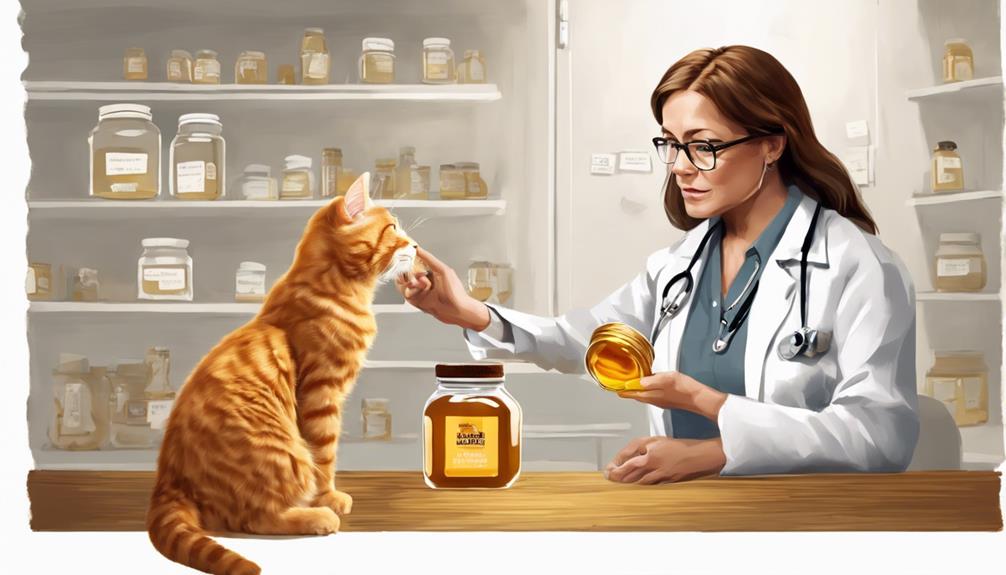
Before presenting honey to your cat, seeking advice from a vet is important to guarantee their safety and well-being. Vets play a significant role in ensuring that your feline friend remains healthy and happy when considering introducing honey into their diet. Here are some important reasons why consulting a vet is crucial:
- Vets can assess any existing health problems in your cat that may be affected by honey consumption.
- Professional guidance can help determine if feeding your cat honey is suitable based on their individual needs.
- Vets can offer insights into potential risks and benefits of honey for your specific cat.
- Consulting a vet ensures that any allergies or sensitivities your cat may have are taken into account before introducing honey.
- Veterinary advice is essential to avoid any long-term health issues that may arise from feeding your cat honey without proper evaluation.
Cats and High Blood Sugar Levels

After consulting a vet about offering honey to your cat, it's important to understand how high blood sugar levels can impact feline health. Cats metabolize sugars differently than humans, and their bodies are not equipped to handle the high sugar content present in honey. This can lead to elevated blood sugar levels, posing risks like diabetes and obesity. To give you a clearer picture, take a look at the table below:
| Aspect | Impact on Cats |
|---|---|
| Lack of glucokinase | High blood sugar levels may occur |
| Long-term consequences | Diabetes and obesity risks increase |
| Disrupted metabolism | Natural diet and metabolism can be affected |
Cats are obligate carnivores, meaning their bodies are designed to thrive on a diet primarily consisting of meat. Introducing sugary substances like honey can disrupt this balance, potentially leading to health complications. Monitoring your cat's sugar intake and avoiding honey can help prevent issues related to high blood sugar levels.
Honey and Weight Gain in Cats

When it comes to honey and its impact on our feline friends, it's important to consider its potential role in weight gain.
The high calorie content in honey can lead to excess energy intake, potentially contributing to obesity in cats.
Keeping an eye on how much honey our cats consume is essential in maintaining their overall health and well-being.
Honey and Cat Weight
How does honey consumption affect a cat's weight, considering its high calorie content and potential for weight gain? When it comes to cats and their health, weight plays an important role. Excessive honey intake can lead to unhealthy weight gain in cats, posing risks to their overall well-being. Here are some key points to keep in mind:
- Honey is calorie-dense and can contribute to weight gain in cats.
- Regular honey consumption can lead to gradual weight gain in felines.
- Cats don't require additional sugar in their diet, as excess calories from honey can result in weight gain.
- The carbohydrate content in honey, mainly fructose and glucose, can increase the risk of obesity in cats.
- Monitoring calorie intake is essential to prevent unhealthy weight gain in cats.
Keeping an eye on your cat's honey intake can help maintain a healthy weight and overall health.
Effects on Feline Weight
Considering the impact of honey consumption on feline weight, it's important to recognize that the high calorie content in honey can potentially lead to weight gain in cats. When a cat licks honey, they're ingesting a concentrated source of calories that their bodies may struggle to process efficiently.
The digestive system of cats isn't well-equipped to handle the high carbohydrate content in honey, which can contribute to weight gain over time. Gradual weight gain in cats can occur with regular honey consumption due to the calorie surplus it introduces.
Excessive honey intake may result in unhealthy weight gain as cats lack the necessary enzymes to digest the sugars effectively. Monitoring your cat's honey intake is essential to prevent potential weight gain issues and maintain their overall well-being.
Honey and Obesity
In relation to feline weight management, the impact of honey consumption on cats' obesity is significant due to its high calorie content. When it comes to a cat's taste buds, honey may seem delightful, but it can contribute to unwanted weight gain. Here are some key points to ponder:
- Honey is high in calories, making it easy for cats to pack on the pounds.
- Cats lack the necessary enzymes to efficiently process the carbohydrates and sugars in honey, potentially leading to obesity.
- The high carbohydrate content in honey can be difficult for cats to digest, increasing the risk of weight gain.
- Regular consumption of honey can lead to gradual weight gain in cats due to the calorie surplus.
- Feeding honey to cats can result in unhealthy weight gain over time, posing risks for their overall health and well-being.
Honey for Wound Care: Not Recommended

Using honey for wound care in cats isn't recommended by veterinarians without proper approval. While Manuka honey is renowned for its healing properties in humans, it shouldn't be used on cat wounds without veterinary guidance.
Cats may lick off the honey, hindering the wound healing process if applied topically. Seeking advice from a vet is essential to guarantee appropriate wound care treatments tailored to your cat's specific needs.
Using honey without professional guidance can delay proper wound healing and potentially lead to complications in cats. Remember, our feline friends have unique sensitivities and requirements when it comes to their health.
Trusting the expertise of a veterinarian is the best way to assure your cat receives the proper care for any wounds they may have. Let's prioritize our cats' well-being by seeking professional advice when it comes to wound care.
Cats and Sugar Metabolism
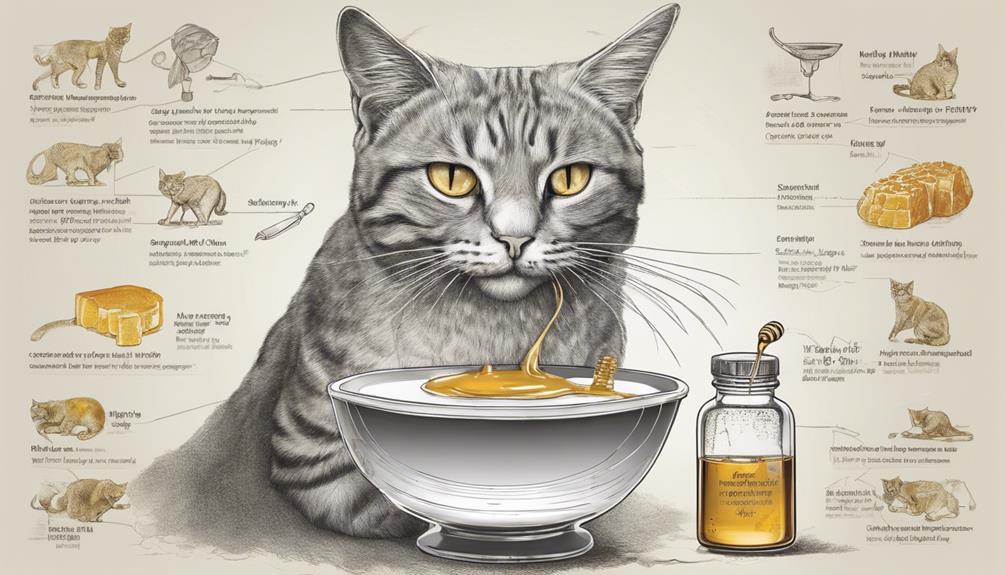
Let's explore how cats' sugar metabolism differs from humans and its implications on their dietary needs.
When it comes to cats and sugar metabolism, there are some key points worth examining:
- Cats lack the necessary enzyme to break down glucose and fructose in honey, making it difficult for them to digest these sugars effectively.
- Ingesting large amounts of honey can lead to gastrointestinal issues like gagging, vomiting, and diarrhea in cats, which can be distressing for both the cat and the owner.
- Honey is high in calories, and regular consumption can contribute to obesity in cats, affecting their overall health and well-being.
- Raw honey may contain botulism spores that are especially harmful to young kittens, posing a significant risk if consumed.
- Feeding cats honey isn't recommended due to their difficulties in digesting carbohydrates, which can lead to potential health risks.
Avoid Feeding Honey to Cats

Feeding honey to cats isn't advised due to potential risks associated with their inability to effectively digest the sugars present. Cats may experience digestive issues like vomiting and diarrhea, and the high calorie content in honey could contribute to obesity.
Additionally, some cats may have allergic reactions to honey, making it important to consult a vet before introducing any amount of honey into their diet.
Cats and Honey Risks
Cats shouldn't be given honey due to the risks associated with their inability to digest its sugars effectively.
- Cats lack the necessary enzymes to break down the sugars in honey.
- Ingesting honey can lead to gastrointestinal issues like vomiting and diarrhea in cats.
- Honey is high in calories and can contribute to obesity in cats.
- Raw honey may contain harmful botulism spores, especially risky for young kittens.
- Veterinarians don't recommend feeding honey to cats due to potential long-term health effects.
It's important to understand that cats are obligate carnivores, and their digestive systems aren't designed to handle sweet substances like honey. So, it's best to stick to their regular diet to keep them healthy and happy.
Potential Allergic Reactions
It's important to be aware that allergic reactions can occur in cats if they are fed honey due to their limited ability to digest its sugars effectively. Cats lack the necessary enzymes to efficiently break down carbohydrates like glucose and fructose found in honey, which can lead to adverse reactions. To highlight the risks associated with feeding honey to cats, let's consider the potential allergic reactions in the following table:
| Allergic Reactions in Cats |
|---|
| Gagging |
| Vomiting |
| Diarrhea |
Being cautious with what we feed our feline friends is vital, especially when it comes to substances like raw honey that can trigger allergies and digestive issues due to their limited ability to process certain components.
Digestive Issues in Cats
When pondering the digestive well-being of our feline companions, it's essential to refrain from offering honey as it may lead to potential gastrointestinal disturbances. Cats lack the necessary enzymes to properly break down sugars like those found in honey, making it challenging for them to digest.
Here are some key points to ponder regarding the use of honey and digestive issues in cats:
- Cats can only handle small amounts of honey due to difficulties digesting carbohydrates.
- Ingesting large quantities of honey can result in gagging, vomiting, and diarrhea in cats.
- Honey is calorie-dense and may contribute to obesity in felines.
- Raw honey carries the risk of containing botulism spores, particularly harmful to young kittens.
- Feeding cats honey isn't recommended due to their limited ability to process sugars.
Aroma Vs. Taste: Cats and Honey

Exploring the contrast between aroma and taste in the context of cats and honey reveals intriguing insights into their dietary preferences. While cats may not possess the gene to taste sweetness, they're still drawn to certain aspects of honey. The alluring scent of honey, especially varieties like manuka honey with their distinct aromas, might catch a feline's attention.
However, when it comes to taste preference, cats are indifferent to the sweetness of honey. Research suggests that cats don't particularly favor sugary foods, including honey, as they prioritize other components like fats or proteins. This means that while the aroma of honey might interest them, the lack of a sweet tooth makes the actual taste less appealing to our feline friends.
Understanding this distinction can help us recognize that cats may be more attracted to the smell rather than the flavor of honey, shedding light on their unique dietary behaviors.
Long-Term Health Issues From Honey Intake

Given the potential long-term health risks associated with honey intake for cats, it's crucial to comprehend how this sweet treat can impact their well-being. Cats face significant challenges when digesting honey, leading to various health issues over time.
Here are some key points to bear in mind:
- Regular honey consumption can lead to gastrointestinal issues: Cats struggle to process the carbohydrates in honey, often resulting in digestive disturbances.
- High sugar levels in honey can be toxic to cats: Their bodies aren't equipped to handle the glucose and fructose found in honey, potentially causing harm.
- Obesity risk from honey: With its high calorie and sugar content, excessive honey intake can contribute to obesity in cats.
- Potential insulin spikes: Cats may experience insulin spikes from consuming too much honey, increasing the risk of diabetic complications.
- Incompatibility with feline dietary needs: Cats are obligate carnivores and should primarily consume animal protein-based diets, making honey an unsuitable long-term addition to their nutrition.
These points underscore the importance of being cautious about integrating honey into a cat's diet to safeguard their long-term health.
Best Practices for Cat Nutrition

To ensure peak health for your feline companion, prioritize a diet rich in animal protein-based foods. Cats, as obligate carnivores, thrive on diets high in animal proteins. When considering your cat's nutrition, it's vital to avoid foods high in sugars like honey.
While honey, including manuka honey, may have health benefits for humans, feeding honey to cats can lead to weight gain, digestive issues, and potential risks of obesity, gastrointestinal upset, and diabetes. Cats lack the necessary enzymes to efficiently process the sugars found in honey, making it an unsuitable addition to their diet.
Before introducing any new food, including honey, into your cat's diet, it's important to consult a vet. Vets can provide tailored advice based on your cat's individual nutritional needs, ensuring they receive a balanced diet that supports their overall well-being. By focusing on high-quality animal protein sources and seeking professional guidance, you can help your feline friend thrive with a nutritionally sound diet.
Vets Perspective on Cats and Honey

From a veterinary standpoint, feeding honey to cats is generally discouraged due to their limited ability to digest sugars efficiently. Cats aren't well-equipped to process the high sugar content present in honey, which can result in various gastrointestinal issues like vomiting and diarrhea. Here are some key points to take into account:
- Cats lack the necessary enzymes to break down the sugars found in honey effectively.
- The consumption of honey can potentially lead to obesity, insulin spikes, and other health complications in cats.
- It's important to consult a vet before contemplating the use of honey for any medicinal purposes in cats.
- The high sugar content in honey can disrupt a cat's delicate digestive system, leading to discomfort and potential health risks.
- Opting for alternative, cat-friendly treats and remedies is a safer choice to safeguard the well-being of our feline companions.
Cat Wellness and Dietary Considerations
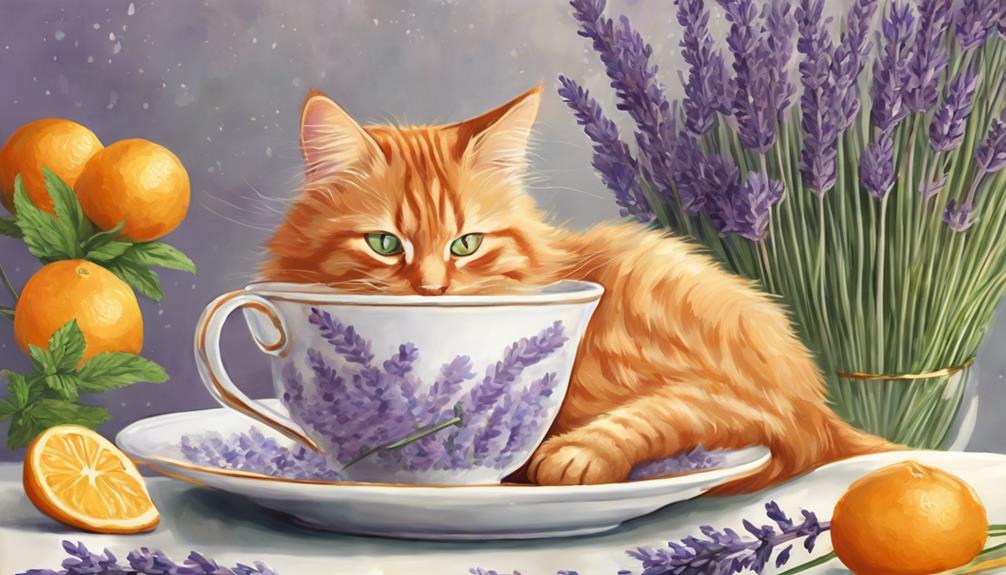
When considering the wellness of our feline companions, it's vital to understand how honey can impact their health. Cats have unique nutritional needs that must be fulfilled to guarantee their well-being.
It's important to be aware of the potential risks associated with feeding honey to cats.
Honey and Cat Health
Considering a cat's carnivorous diet, honey's compatibility with feline health remains a topic of concern within the veterinary community. While raw honey contains carbohydrates and sugars that may not align with a cat's dietary needs, processed honey could potentially upset their stomach with empty calories.
However, manuka honey stands out for its antibacterial properties, offering potential health benefits for cats. It's essential to consult a vet before incorporating honey into a cat's diet to address any dietary differences and minimize risks. The effectiveness of components like MGO in manuka honey plays a significant role in supporting cat health.
- Raw honey may not align with a cat's carnivorous diet.
- Processed honey could upset a cat's stomach with empty calories.
- Manuka honey offers antibacterial properties beneficial for cats.
- Consulting a vet before adding honey is vital.
- The potency of components like MGO in Manuka honey affects its effectiveness.
Nutritional Needs of Cats
Pivoting from the discussion on honey and cat health, the nutritional needs of cats are fundamentally centered around their obligate carnivorous nature, emphasizing a diet rich in animal proteins for peak wellness.
Cats have specific dietary requirements, such as taurine for heart and eye health, omega-3 fatty acids for a luscious coat and strong immune system, and a low need for carbohydrates due to their inability to efficiently process sugars.
It's crucial to provide a balanced diet tailored to meet these needs to guarantee your feline companion thrives and avoids health complications. While delicacies like manuka honey or raw honey might be tempting, sticking to a diet that suits their carnivorous instincts is the key to keeping your cat healthy and happy.
Risks of Honey
Exploring the risks of honey in relation to cat wellness and dietary considerations reveals significant concerns regarding feline health. When it comes to feeding honey to cats, several risks need to be considered:
- Cats lack the necessary enzymes to break down the sugars in honey efficiently.
- Regular consumption of honey can lead to gastrointestinal issues like vomiting and diarrhea in cats.
- The high calorie content in honey can contribute to obesity in cats over time.
- Raw honey may contain botulism spores that are harmful, especially for young kittens.
- Veterinarians don't recommend feeding honey to cats due to concerns about their ability to digest carbohydrates.
Considering these risks, it's best to avoid giving honey to your feline companions and opt for safer alternatives for their overall well-being.
Safety Precautions for Cat Health

To guarantee peak well-being for your feline companion, prioritizing safety measures is crucial. When it comes to your cat's health, being proactive and taking precautions can prevent unnecessary risks. Here are some key safety tips for ensuring your cat stays healthy and happy:
| Safety Measure | Description |
|---|---|
| Proper Feeding | Make certain your cat's diet is balanced and suitable for their age and health needs. Avoid feeding them foods that are harmful, like honey, and opt for cat-friendly treats. |
| Regular Vet Check-ups | Schedule routine check-ups with your veterinarian to monitor your cat's overall health and catch any issues early on. Vaccinations, deworming, and dental care are essential for their well-being. |
| Wound Care | Keep an eye out for any wounds or injuries on your cat. Clean cuts promptly with mild soap and water, and consult your vet if the wound seems severe or gets infected. |
Frequently Asked Questions
What Happens if a Cat Eats Honey?
When a cat eats honey, it may experience gagging, vomiting, and diarrhea due to difficulties digesting carbs. The high calories in honey can lead to obesity. Raw honey can contain botulism spores, especially harmful to kittens.
How Much Honey Can I Give My Cat?
Aware that honey can be tempting, but for our feline friends, moderation is key. Cats struggle to digest honey's sugars, so limit to a lick on rare occasions. Excessive honey can lead to tummy troubles.
Can Cats Eat Peanut Butter and Honey?
We enjoy peanut butter, but honey isn't safe for cats due to its high sugar content. Combining them isn't recommended as it can cause digestive issues and weight gain. Stick to vet-approved treats for your cat's health.
Can I Put Honey on My Cats Wound?
We've researched using honey on cat wounds. It can have antibacterial benefits but requires vet approval due to cats licking it off. Like a delicate dance, honey should be part of vet-recommended treatment plans.
Is It Safe for My Cat to Eat Honey if I’m Concerned about their Diet?
It is not safe for cats to eat honey. While it may seem like a natural sweetener, honey can contain botulism spores that are harmful to cats. Stick to a balanced diet formulated for feline nutrition to ensure safe eating for cats.
Conclusion
To sum up, while cats may enjoy the taste of honey, it's best to avoid giving it to them due to potential health risks. Check with your vet before introducing any new foods to your feline friend to safeguard their well-being.
Remember, even though they may beg for a taste, it's crucial to prioritize their health above all else. Keep your furry companion happy and healthy by sticking to a balanced and vet-approved diet.
